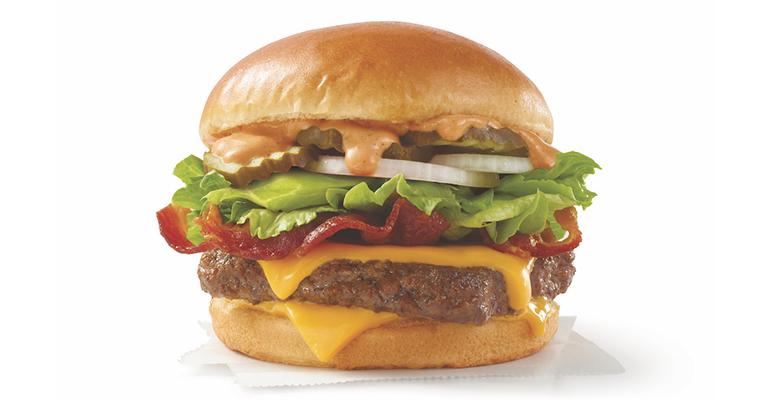Wendy’s has temporarily removed beef from some of its menus, according to analyst reports, and other large burger chains are eyeing their own protein supply chains with caution amid production interruptions caused by the COVID-19 pandemic.
The investment bank Stifel said it conducted a random sampling of Wendy’s restaurants and determined that between 5% and 10% were only offering chicken.
Financial firm Stephens put that number at closer to 17% after analyzing all of the chain's online menus.
In a report by analysts led by Chris O’Cull, Stifel said it believed Wendy’s use of only never-frozen beef made the chain particularly vulnerable to supply disruption caused by the closure of beef processing plants.
“It would be accurate to say that some of our menu items may be temporarily limited at some restaurants at this time,” a Wendy’s spokesperson confirmed, adding that beef was being supplied to all of the system’s roughly 5,800 restaurants nationwide two to three times a week, “which is consistent with normal delivery schedules … We’re working diligently to minimize the impact to our customers and restaurants, and continue to work with our supplier partners to monitor this closely.”
A number of beef and other livestock processing facilities have closed temporarily either as a result of COVID-19 outbreaks at the plants or fears of the virus spreading due to outbreaks in the communities where they operate.
Although the Trump administration has ordered those plants to reopen, social distancing measures implemented to protect the health of employees would result in reduced production anyway.
McDonald’s, in its earnings call last week, said there had been no break in its supply chain. However, the chain later said that it has changed its approach to supplying certain protein items to its roughly 14,000 domestic locations. Instead of taking orders for beef and pork products from each location, the parent company is proactively sending those items based on anticipated demand to ensure that every restaurant gets what it needs.
In an interview with CNBC last week, McDonald’s CEO Chris Kempczinski described the North American meat situation as “concerning.”
“We are monitoring it literally hour by hour. Right now, we feel like we are in a good position, but there is concern there. …I think because we’re McDonald’s, we have access to all of our suppliers and we have a special relationship with them, and certainly our expectation is that they will make sure they do everything they can to guarantee our supply,” he said
Toronto-based Restaurant Brands International, parent company of Burger King as well as Popeyes Louisiana Kitchen and Tim Horton’s, said in a quarterly earnings call on Friday that none of the brands had experienced supply-chain disruptions but that they were monitoring the situation.
“We’re, obviously, working closely with the suppliers and our distribution partners as well to make sure we have all of our contingency plans in place,” CEO Jose Cil said.
In an email to Nation’s Restaurant News, a representative from Burger King said the chain “does not anticipate any widespread changes to our restaurant menus as a result of the beef shortage. We are closely monitoring the situation, and working with our suppliers to ensure a secure supply of beef to avoid any impact in our restaurants.”
According to the United States Department of Agriculture, although less than 10% of the nation’s beef processing capacity is offline, most plants that are operating are doing so at between 50% and 75% of normal capacity to allow for necessary distancing between workers.
A supply chain expert at the National Cattlemen’s Beef Association said they expected the disruptions to be “short-lived,” meaning weeks or months.
“There is no shortage of cattle,” Bridget Wasser, executive director for meat science, culinary and supply chain at the NCBA, said in an email. “The supply disruptions you may see in the channels today are related to processing disruptions and logistical challenges in areas of labor and transportation.”
These disruptions have resulted not only from plant closures, but a shifting demand from foodservice, where traffic fell sharply as restaurants closed their dining rooms and consumers stayed at home, to grocery stores which saw a sharp increase in demand for meat.
“As restaurants begin to reopen dining rooms, another shift in the supply chain will be necessary to divert product back to the foodservice segment, while keeping up with demand at retail. Any disruptions in supply should be short-lived as the industry adjusts to manage demand,” Wasser said.
However, those shifts could result in price fluctuations, she said, particularly for ground beef at quick-service restaurants and middle-meat steaks in casual and fine-dining restaurants, namely rib eye, tenderloin and strip steaks.
According to Market Vision, which monitors the foodservice supply chain, beef production has fallen markedly since the spread of the novel coronavirus gained speed in the United States. Since mid-March, cattle slaughter is down by around 25% due to reduced capacity in the beef processing system. The result is skyrocketing beef prices and a simultaneous decline in cattle prices — without the ability to slaughter the cattle, demand for them is down.
As a result of lower cattle prices, fewer animals are going to feedlots to be fattened for slaughter, meaning that even once processing capacity returns in full, fewer cattle might be available, resulting in sustained higher prices.
Market Vision said cattle futures have fallen from $125.17 per hundred pounds in January to $87.25 in early May. By contrast, retail prices of choice beef top round is at $5.68 per pound, up by 142% in the past two months, Market Vision said.
Contact Bret Thorn at [email protected]
Follow him on Twitter: @foodwriterdiary

